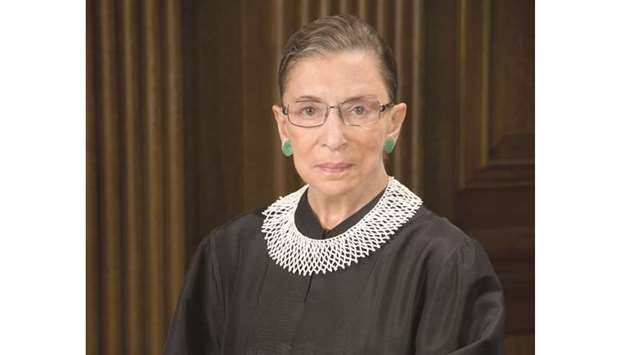These are fraught times for anyone concerned with the ideological balance of the United States Supreme Court. With the appointment of right-leaning Brett Kavanaugh to a seat on the court, this new biography of liberal stalwart Ruth Bader Ginsburg will be snatched up by those eager to learn what makes RBG (as her adoring millennial fans call her) tick and to seek reassurance that the 85-year-old Ginsburg can shore up the court’s embattled liberal minority.
Ruth Bader Ginsburg: A Life ably makes the case for Ginsburg’s iron will to succeed and for her standing as a brilliant lawyer and jurist, but it is an incomplete personal portrait of a very private woman. It’s an unauthorised biography: Although Ginsburg agreed to six interviews and made available her legal files from her career as an American Civil Liberties Union attorney, author Jane Sherron De Hart had no access to any diaries or personal letters from Ginsburg’s early life. De Hart, professor emerita of history at the University of California, Santa Barbara, also reveals that in 2008, in the middle of the project, she lost her home, her research, and two completed manuscripts of her writings on Ginsburg in a California wildfire.
In a straightforward, linear chronology, De Hart lays down the tracks of Ginsburg’s life. Ginsburg was born in Brooklyn in 1933 to middle-class parents. They admired and doted on their brilliant daughter and helped instill in her the concept of repairing the world. Her mother, Celia Amster Bader, was the chief nurturer; mother and daughter were extraordinarily close. It was a devastating blow to Ginsburg when she lost her mother to cancer just two days before her high school graduation.
At Cornell, she excelled academically and met the love of her life, Martin Ginsburg. It was a love match for the ages; Marty, who would become a successful tax lawyer, supported his wife at every turn; cooked gourmet dinners for family, friends and colleagues; and mounted a personal Washington campaign to advance his wife’s nomination to the US Supreme Court. His family’s relative wealth ensured that the busy couple had the resources they needed to excel.
Younger readers may be taken aback at the discrimination Ginsburg confronted as a young woman aiming for a career in the law. To gain admission to law school, she had to surmount restrictive quotas for women (10 percent of the slots in many schools); although she had a brilliant record and a prodigious appetite for hard work, she could not find a job, hobbled in part by her ‘small size, soft voice, youthful image and feminine appearance.’ Only the intervention of a Columbia University law school mentor set her on her path with a key clerkship to a federal appeals court judge.
De Hart’s narrative is most revealing when she analyses Ginsburg’s work as a brilliant legal strategist whose advocacy career began in earnest in 1972 when she helped found the Women’s Rights Project at the ACLU. From that point on, Ginsburg’s mission was to bend the law toward equal rights, first as a litigator, then as a federal appeals court judge, and finally as a US Supreme Court judge. De Hart displays an impressive grasp of each area of Ginsburg’s legal influence, from women’s rights to voting rights to gay rights to immigrant rights, with a particular focus on striking down laws that discriminated on the basis of gender. Her eye was on equality, even as the court swung further to the right with each passing decade.
De Hart’s fidelity to detail in these matters may frustrate those hoping for more about Ginsburg’s private life. Her long and happy marriage, her love of opera, her ability to forge friendships with ideological opponents such as conservative Supreme Court justice Antonin Scalia, her struggles with her own cancer and Marty’s, these stories are inspiring, but they offer few windows into the dark times that any human soul must endure. Ginsburg is a warrior and does not show weakness easily ‘she absolutely doesn’t forgive herself,’ observed daughter Jane. Statements from friends and colleagues are largely encomiums. However sincere, there’s a certain deadening quality to praise heaped on praise.
And what does Ginsburg think of the future of the court, and the country? The book ends short of Kavanaugh’s appointment to the court, and Ginsburg is still very much on stage, so those questions remain unanswered. A complete portrait of her inner struggles, and the outcome of her very public ones, will have to wait for a future biography.– Newsday/TNS

JURIST: Ruth Bader Ginsburg is an Associate Justice of the Supreme Court of the United States and was appointed by President Bill Clinton and took the oath of office on August 10, 1993.
